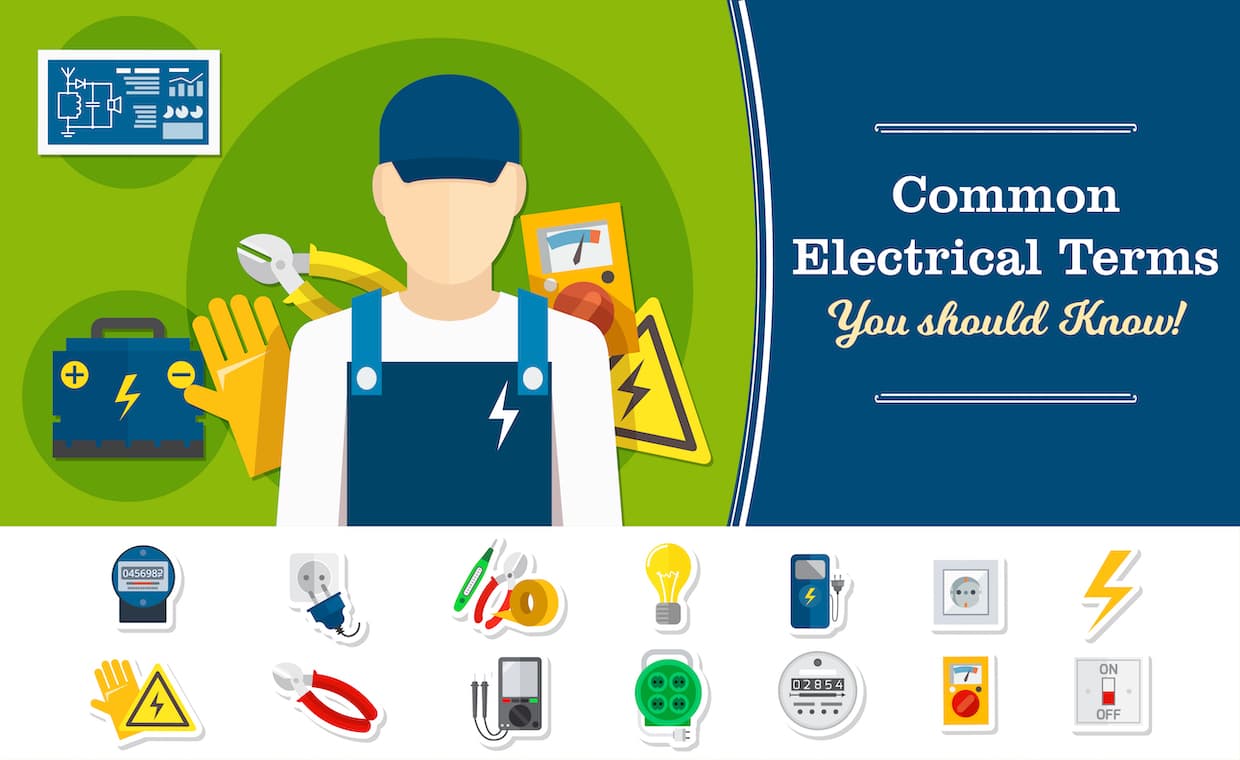
We tend to take electricity supply for granted, but it would do us good to gain a grasp over the basics. Gharpedia through this blog runs you through a quick overview of the home electrical system including some of the common electrical terms.
When you flip on a light, you’re probably not giving much thought to where the power for that light comes from. Power lines carry electricity to a meter located outside your house, which monitors the amount of energy you use each month. Wires from the meter lead to the main service panel (housing the circuit breakers or fuses), which can be outside or inside the house or garage. This panel is where you’ll find the main switch that can shut off power to the entire house.
Wires from each circuit breaker or fuse in the main service panel branch off through the house. Each grouping of wires is referred to as a circuit. These circuits provide power to your fixtures and receptacles.
Home electrical systems are rated for the maximum amount of current (measured in amperes) they can carry, which is called the service rating. The minimum service rating of most new homes today is 100 amps. However, your service rating could be as low as 40 amps if your house is old; or as high as 400 amps if you have lots of high-tech equipment. You can determine your service rating by looking at the main service panel. The number will be stamped on the main fuse or circuit breaker. Why should you care? Well, you need to care because your electrician will ask for your service rating when you plan for a major remodeling, which demands circuits for new appliances. Sometimes, if you are already close to being maxed out, you can’t just add a new circuit; you’ll need to have an electrician upgrade your entire service panel, which can turn out to be a tad expensive.
First Things First!

Doing your own electrical work can be a risky proposition because you are at the risk of either getting shocked or starting a fire!
DIY projects in this arena need to be carried out with extreme caution at all times. The most important rule is to make sure the power is off before doing any electrical work. Not just ‘think’ it’s off, not just turn off the switch for that fixture, but turn the power for that circuit off at the main service panel.
Your indispensable tools for this project are electrical testing devices. There are many products that can be used for the same purpose – to check whether a receptacle or wires have power or not. A voltage tester has one or two probes that you touch bare wires or terminals with. If the tester lights up, the wires are hot (electrical current runs through them). A circuit tester plugs into a receptacle and different lights tell you a range of things, including if the receptacle is grounded or wired correctly.
Whenever you need to touch the main service panel, make sure the ground you’re standing on is completely dry. Use one hand to touch the panel. Your other hand should be empty and at your side because there’s less of a chance of getting an electrical shock if only one hand is touching the panel.
Understanding the Electrical System Terminology and Processes
Fuses and Circuit Breakers


You will find either round fuses or circuit breakers that look like toggle switches inside your main service panel. Both fuses and circuit breakers guard electrical systems against damage that can be caused by too much current. If wires are ever forced to carry more current than they can handle safely, a circuit breaker will ‘trip’ (switch itself off) or a fuse will blow and the power will be lost on that circuit. A blown fuse has to be replaced, but a tripped circuit can be switched back to the ‘on’ position. However, if this is happening frequently, then you’re putting too much demand on that particular circuit or the whole system. Have an electrician come and troubleshoot it for you. In any case, before you call someone out, see if you can figure out under what circumstances the fuse blows or breaker trips (for example, does it only happen when both the space heater and the hair dryer or AC ‘s are on?)
Shutting off a Circuit Breaker

It works like a light switch. Simply flip the circuit breaker to the ‘off’ position when you want to kill power to that circuit. Flip it back ‘on’ when you want to restore power.
Shutting off a Fuse

If your fuse has a handle, pull it towards you and then remove the fuse from its mounting clips with your fingers or a tool called a ‘fuse puller’. If your fuses don’t have handles, they are the screw-in types. Grab the rim of the fuse with your fingers and unscrew it by turning it counter clockwise. If a fuse has blown, the metal wire or strip visible behind the glass will appear to be broken. If you need to replace a blown fuse, buy a replacement with the same amperage rating and just screw the new one into place.
Grounding / Earthing
You’ve probably heard people say ‘that receptacle is grounded’ and thought ‘What did it do wrong?’ Actually, in electrical terms, grounding / earthing system is a good thing. This safety feature provides excess current with an uninterrupted metal pathway into the ground rather than into you or your expensive computer. Power surges are rare and your system may never experience one, but if it does, grounding can save your life. If you don’t know whether your receptacles are grounded or not, buy a circuit tester, plug it into the receptacle and it will tell you.
Common Electrical Terms
1. Ampere (or Amp)

An amp basically depicts the amount or quantity of current that flows past a given point in one second.
2. Circuit
These are two or more than two wires that provide a path for electrical current to flow from the source and back. A circuit is also like an ‘electrical neighbourhood in your house. Big electricity guzzlers like clothes dryers often require their own circuit.
3. Circuit Breaker

This is the switch in the main service panel that cuts off the flow of electricity to that circuit. There are mainly three types of circuit breakers are available: Standard, AFCI circuit breakers and GFCI breakers.
4. Current
This represents the flow of electrons through a conductor and is measured in amps.
5. Fuse

This is a electrical safety device found in older homes that protects circuits from overloading. When a circuit overloads, a metal wire or strip inside the fuse melts or ‘blows’, cutting off power to the circuit.
6. Ground / Earthing

This is any conducting body such as a small metal rod driven into the earth that gives electrical current a path to the ground.
7. GFCI

GFCI stands for Ground Fault Circuit Interrupter. A GFCI receptacle protects against electric shock and is required in areas that could be wet, such as bathrooms and kitchens. A GFCI breaker is installed in the main server panel and monitors the amount of current going to and coming from a circuit.
8. Grounding/ Earthing Wire
This is a conductor that grounds a metal component but does not carry current during normal operation. Grounding wires are usually bare copper or green wires.
9. Hot Wire

This type of wire is the star player in carrying electrical current from its source to a receptacle, switch or other points. Hot wires are usually identified by black or red insulation but may be any colour other than white, grey or green.
10. Housing Box

These are the electrical connection points for joining wires or mounting receptacles, fixtures and switches. Boxes can be metal or plastic and they sit just inside the wall and houses the connections so that you can have access to them when you need to. Depending on its intended usage, a housing box is also referred to as receptacle box, junction box, cut-in box or pancake box.
11. Insulation
This is the thermoplastic material that covers bare wires and protects you shocks.
12. Kilowatt-Hour (KWH)
This is the unit used for metering and selling electricity. One kilowatt-hour equals 1,000 watts used for one hour. This is the unit for measurement of electrical power.
13. Neutral Wire

This is a grounded conductor that completes a circuit by providing a return path to the source. Neutral wires are usually identified by white or grey insulation.
14. Pigtail Splice

This is a connection of three or more electrical type of wires.
15. Receptacle

This is basically a fancy name for what you plug stuff into. The terms ‘receptacle’ and ‘outlet’ can be used interchangeably.
16. Terminals

These are the screws on the side of a switch or receptacle that you wrap wires around to transfer electrical power to that switch or receptacle.
17. Volt (or Voltage)
The force causing electrical current to flow is measured by the utility company in volts.
Important Pointers For Home Electrical System
- When you turn off a circuit or fuse in the main service electrical panel box for a repair, you want to be sure that no one comes along and restores the power to that circuit while you’re working. If you think this is a possibility then put a sign on the service panel that reads: Working on circuit, do NOT turn on.
- Prior to embarking on any major electrical project, do check with your local building department if a permit is necessary. Please don’t avoid the permit process out of fear. The inspectors are there to help ascertain that work is carried out properly and safely; they’re making sure your house won’t burn to the ground. So pay the fee (which is often nominal), get your work inspected and stay safe!
The pointers and basic electrical knowledge shared in this blog are enough to get you started on your home electricity DIY project, aren’t they?
Don’t forget to read below article:
31 Tips to Prevent Electrical Hazards During Holidays
Image Courtesy: Image 6, Image 10
Author Bio
Huta Raval – An English Literature and Journalism Topper, Huta Raval has graduated from the L D Arts College, Ahmedabad. Post serving for 23 years in the NBFC and Public Library Sectors her desire for ‘writing the unwritten’ brought her to the creative field of content writing. Her clientele comprises of NGOs, Blogging Platforms, Newspapers, Academic Institutions, et al.






























